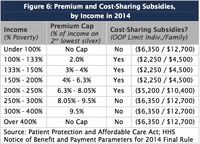 The Affordable Care Act is based on one assumption and three corollaries. The assumption is:
The Affordable Care Act is based on one assumption and three corollaries. The assumption is:
There can be no unlimited draw from a limited pool
The three corollaries are:
- Everyone gets into the pool, and everyone has skin in the game.
- Technology will show the best practices, and best practices should be followed.
- Competition is good.
The third corollary was put in by Republicans, whose allies have spent the last six years disproving it in their attempt to tear down the other corollaries and, in the end, destroy the Obamacare system.
Competition is good, but its aim is to win, and the prize for winning is market power, which the rules dictate must then be used on behalf of shareholders. Great in theory, but in practice inherently messy, and as subject to corruption as any government-run system.
Once this election is over we’re going to all face the problems of Obamacare beyond Obama, because we’re all getting older. Americans aren’t doing it as fast as Europeans or Asians, thanks to immigration, but we’re all doing it, each one of us.
![DANA AND JENNI 2009[1] DANA AND JENNI 2009[1]](https://www.danablankenhorn.com/wp-content/uploads/2023/07/6a00d83451da3169e201b8d1cb05f0970c-250wi.jpg) The warrantee on this 61 year old body has expired, as has that on my wife. We were able to see health care as theoretical for years, but this is changing. It’s also at this age that you learn what your parents really left you – a collection of conditions and disease vectors that wind their way towards the grave.
The warrantee on this 61 year old body has expired, as has that on my wife. We were able to see health care as theoretical for years, but this is changing. It’s also at this age that you learn what your parents really left you – a collection of conditions and disease vectors that wind their way towards the grave.
In my own case, I’ve been fortunate that my dad’s high cholesterol and hypertension are now controllable by generic medication. The same is not true for the left-foot bunion I also inherited. The big toe is bone-on-bone, I can no longer run, and a lifetime of adjustment to that side means sciatic pain on the other side.
My partner in this life has learned that those bowlegs that attracted me to her also grind down knees. Her dad’s tendency to create fibrous cysts and fat deposits, along with a family history of breast cancer on her mother’s side, must also be dealt with.
We have the “good” insurance. But good isn’t great. The main impact of Obamacare on our insurance has been to raise deductibles and co-pays. Before what should be routine tests, $1,600 in checks had to be written. The “good” insurance, paid for by employers, also leaves choices to patients they don’t know how to face, and it makes them easy prey for hospitals that resist change.
 We know what best practices should be. The Mayo Clinic takes in patients, tests them through diagnosis, and then treats them in the facility until they can be safely discharged. It’s an intense process, but it delivers two important values – control and certainty. The patient, their diagnosis and treatment, is within the control of one united team. Certainty means the patient finds out as soon as possible what they have, what must be done, and they get it done.
We know what best practices should be. The Mayo Clinic takes in patients, tests them through diagnosis, and then treats them in the facility until they can be safely discharged. It’s an intense process, but it delivers two important values – control and certainty. The patient, their diagnosis and treatment, is within the control of one united team. Certainty means the patient finds out as soon as possible what they have, what must be done, and they get it done.
Most private hospitals don’t subscribe to this best practice. For the convenience of doctors, most private hospitals (both for-profit and non-profit) are surrounded by warrens of offices, with a variety of specialists, who have a variety of views, doing tests, diagnosis and treatment in isolation.
You feel a lump. Go to this person. But first get on the schedule. They do a test. You need a further test and wait a week for it, then another week for yet-another office to evaluate the results. Maybe, if you’re lucky, it’s nothing.
 Hospital costs and pricing are still opaque in the current Obamacare system. Where competition exists, insurers may find some bargains. Where it does not – and hospitals are engaged in a mania of mergers to assure it does not – even Obamacare prices can be highly inflated. It may cost you twice as much, per month, for an ACA policy in rural Georgia as in Atlanta, due to this lack of competition.
Hospital costs and pricing are still opaque in the current Obamacare system. Where competition exists, insurers may find some bargains. Where it does not – and hospitals are engaged in a mania of mergers to assure it does not – even Obamacare prices can be highly inflated. It may cost you twice as much, per month, for an ACA policy in rural Georgia as in Atlanta, due to this lack of competition.
Competition, moreover, is not just about price. There are many dimensions to market competition. Brand and marketing are just two of the more wasteful dimensions. Then there is the creation of false need, which is where the ACA regime really breaks down.
In order to get the bill passed, Democrats had to accept that the drug approval process would remain as it was, and that Medicare, Medicaid, even private insurance groups, could not bargain on price. This means that once the FDA agrees that a drug or device works, its maker is free to sell it to anyone. They can name their own price, and so long as they convince a doctor to use it – by any means – it will be used.
 In civilized countries, drug and device approval is a two-step process. First, the maker has to prove that the thing works. Second, they must prove that it is a good bargain. Americans don’t have this protection, which makes them subject to TV ads, to salesmen with their sample cases, and to all the other shenanigans makers and medical groups may dream up. This is why, even 6 years after the law’s passage, Americans still put 17.5% of GDP into health care.
In civilized countries, drug and device approval is a two-step process. First, the maker has to prove that the thing works. Second, they must prove that it is a good bargain. Americans don’t have this protection, which makes them subject to TV ads, to salesmen with their sample cases, and to all the other shenanigans makers and medical groups may dream up. This is why, even 6 years after the law’s passage, Americans still put 17.5% of GDP into health care.
There is a potential control. United Healthcare, while loudly proclaiming it’s leaving the Obamacare exchange, is actually doing this through a new unit called Harken Health. Kaiser Permanente and Intermountain have done this for years. New companies like Centene, which focus on Medicaid and Medicare patients, also do this.
You limit the network.
You tell patients that when you buy our insurance, you go to our primary care doctor. They will use data and best practices to get you the best care at the lowest cost, and focus on keeping you out of the hospital. When you need more care, you will go to the practices they contract with, at prices they negotiate.
This is the new business model built into the Obamacare system. Instead of charging a fee for each service performed, the new model is that insurers get a set amount of money each year, and if the patient gets through the year for less they profit. That’s change they can believe in. It’s incredibly valuable among the millions of people with chronic conditions like diabetes and kidney failure. These companies profit by getting people to comply with doctors’ orders. The employer-paid model profits more when they don’t.
 The employer-paid model does not work. Fee for service encourages services in order to generate fees. It enables enormous amounts of waste, in the name of “choice” for both doctor and patient. Frankly, patients who aren’t doctors aren’t really capable of making the choices doctors, hospitals, and other professionals need to make every day. We’re just not. We don’t know the best value for a knee replacement, especially since we’re not given pricing or much quality data on which to base a choice. We do what the doctor we trust tells us, and the doctor does what is in the doctor’s best interest, data be damned.
The employer-paid model does not work. Fee for service encourages services in order to generate fees. It enables enormous amounts of waste, in the name of “choice” for both doctor and patient. Frankly, patients who aren’t doctors aren’t really capable of making the choices doctors, hospitals, and other professionals need to make every day. We’re just not. We don’t know the best value for a knee replacement, especially since we’re not given pricing or much quality data on which to base a choice. We do what the doctor we trust tells us, and the doctor does what is in the doctor’s best interest, data be damned.
This has to change. Data, science, and best practices need to drive decision-making, not the whims, gut instinct, or financial health of a particular practice. Insurers need more power to bargain with hospitals and clinics. They need to be able to actually buy hospitals, as well as clinics, and maintain patient control.
Sure, we need more information on pricing, and quality grades, and all of that. But mostly the health care system needs control and certainty. If you think I’m sick, tell me what I’ve got, as quickly as possible. Don’t leave me in suspense. Then get to work on it.
Cure me.










A good, informative article about a subject that had been previously very cluttered with misinformation. Thank you!
A good, informative article about a subject that had been previously very cluttered with misinformation. Thank you!